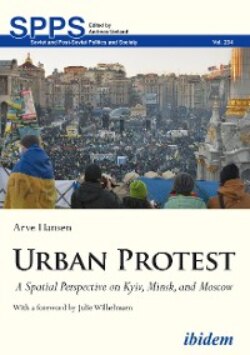Читать книгу Urban Protest - Arve Hansen - Страница 3
ОглавлениеContents
Abbreviations
A Note on Language
Foreword by Julie Wilhelmsen
Preface
1 Starting Point
Part I
2 Space in Context
2.1 Complexities of Urban Contention
2.1.1 Form
2.1.2 Motivation
2.1.3 Waves
2.2 Ukraine, Belarus, and Russia
2.3 Relevance
3 Mapping the Field
3.1 Protests
3.1.1 Repertoires
3.1.2 Nonviolent Contention
3.1.3 Colour Revolutions
3.1.4 Non-spatial Factors
3.2 Space
3.2.1 Public Space
3.2.2 Physical Space
3.2.3 Contested Spaces
3.3 The Gap
4 Definitions and Research Questions
4.1 What Is a Mass Protest?
4.2 What Is Urban Public Space?
4.3 Research Questions
5 Theorising and Development
5.1 Approaches to Theorising
5.1.1 Field Work
5.1.2 Respondents
5.1.3 Mapping
5.2 Ethical Considerations
5.2.1 Interview Ethics
5.2.2 Practical Utility
5.3 Geographical Determinism
5.4 Conception
5.4.1 M.A. Thesis
5.4.2 PhD Proposal
5.5 Theorising
5.5.1 Prestudy
5.5.2 Formulating a Theory
5.5.3 Transitional Study
5.6 Causal Chains
5.7 Main Study
5.8 Post-test Theorising
6 Variables and Methodology
6.1 Independent Variables
6.1.1 Perceived Elements
6.1.2 Physical Elements
6.1.3 Social Elements
6.2 Intermediary Variables
6.2.1 Spatial Qualities
6.2.2 The Political Environment
6.3 Dependent Variables
6.3.1 Emergence
6.3.2 Realisation
6.3.3 Impact
Part II
7 Prestudy
7.1 Physical Space
7.1.1 Spatial and Urban History
7.1.2 Daily Use
7.1.3 Protest Space
7.2 Symbolic Value
7.2.1 25 Years of Protest
7.3 Function
7.4 Conclusions
8 Transitional Study
8.1 A Spatial Perspective
8.2 Belarusian Protests from Glasnost’ to Lukashenka
8.3 Perceived elements
8.3.1 October Square
8.3.2 Independence Square
8.4 Social Elements
8.4.1 The Political Centre
8.4.2 The People’s Centre
8.4.3 Independence Square
8.4.4 October Square
8.5 Physical Elements
8.5.1 October Square and Ploshcha 2006
8.5.2 Independence Square and Ploshcha 2010
8.6 Conclusions
9 Main Study
9.1 Towards a Spatial Perspective
9.1.1 Spatial Elements
9.1.2 Spatial Qualities and the Political Environment
9.1.3 Protest Areas
9.2 Moscow, Swamp Square and the March of Millions
9.2.1 The Political Environment of Moscow
9.2.2 Public Spaces in Moscow
9.2.3 The Elements
9.2.4 Spatial Qualities
9.2.5 Emergence, Realization, Impact
9.3 Conclusions
Part III
10 To Paris and Beyond
10.1 Republic Square and the Yellow Vests
10.1.1 Applying the Model
10.2 Summary and Conclusions
10.2.1 “So what?”
10.2.2 Limitations
10.3 Moving On
References
